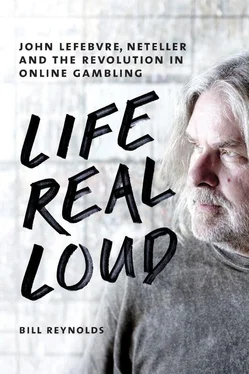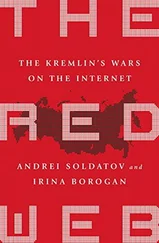* * *
“They took me downstairs and made me dress in some orange jumpsuit shit,” he begins. “Then they marched me across and put me in this room. Probably in the basement and across the way to a building that was a prison.”
Lefebvre was marched across Pearl Street, underground, to the building across from the Moynihan, the MCC, 150 Park Row, a Brutalist skyscraper opened in 1975. Its famous “guests” have included Gambino family crime boss John Gotti; the king of Ponzi schemes, Bernie Madoff; the blind Muslim preacher Omar Abdel-Rahman, who exhorted the 1993 World Trade Center bombers on to jihad; Ahmed Ghailani, the first Guantanamo Bay prisoner brought to the U.S. to stand trial, specifically for his role in the August 7, 1998, bombings of U.S. embassies in Nairobi, Kenya, and Dar es Salaam, Tanzania; Horst Walther Overdick Mejía, a.k.a. El Tigre, a cocaine trafficker who helped the Mexican Los Zetas cartel take over northern Guatemala; and Gilberto Valle, the New York Police Department officer who used police databases to compile a list of one hundred women he wanted to kidnap, rape, torture, murder, cook, and eat. Lefebvre’s eventual destination and temporary home is called 7 South, but first he’s brought into a room.
He continues,
The first holding tank, I was in with a guy who had cut himself and written on the wall in that really cool tag writing that graffiti guys use. I can’t remember, it was a four-letter word, like “WAIT” or “TIME,” and he scratched it on the wall in blood. Everybody does that. Sit there long enough and scratch your name into the bench with your fingernails.
I asked Sam, my bunkee, who has shoulders as big as my head, “A lot of these guys in here gang guys, Sam?” When he smiles he looks like Jimi Hendrix. He’s twenty-five, twenty-six years old, built like Joe Frazier.
“Nah, not really. I don’t think they’s any gang guys in here.”
The next day, I’m playing chess with this guy named Grady. He’s a killer chess player; so adept. I say to him, “Sam says not many of these guys are gang guys.”
He sits back and he folds his arms and he says, “Your bunkee? He Blood.”
Lefebvre was discovering an order to the jail he didn’t know existed.
One of the first things they asked me when I went in was, “You got any seps?”
I said, “What? I don’t know what you’re talking about.”
“If you don’t know what I’m talkin’ about you don’t have any.”
“Separations,” says Lefebvre. He continues,
So in my wing there were no Crips, just Blood. The Crips are in another wing. They ask you. The Crips know if you’re a Blood — they know ya . Somebody knows you. They know everything, right? So you don’t want to be in there. You don’t say, “I’m no Blood.” You say, “You can’t put me in with no Crip.” If you say, “I’m Blood,” that’s the same as saying, “I’ve committed the crime of racketeering.” So you don’t say that.
So that’s why Sam said, “Ain’t no gangs in here.” But nine or ten guys in my tier were Blood.
The first night, they put Lefebvre and everyone else who got processed that day in a space nicknamed “the hole.” This is a triage area where guards can cut new prisoners down a notch or three. They put all the men in handcuffs behind their backs so they can control them. They put however many they’re moving that day inside a single cell. Once everyone’s inside, they open the little meal slot. They tell each prisoner to stick his hands through so they can take off the cuffs. “There’s seven guys there,” says Lefebvre. “It’s tight, it’s crowded, it’s packed, it’s stuffy. An hour or so later they come around and you put your hands through and they cuff you. You’re ready to be taken to your cell. The hole is the place they take you to punish you.”
That was humiliating enough, but then the new prisoners had to deal with a malcontent. Lefebvre recalls,
There was one guy in the hole, in the first cell. You had to walk by him. The whole time we were in there, the whole night, he never stopped. In your cell, your toilet is right by that door. There’s a little glass window on the door, so when you’re going to have a dump what you do is, your cellee, he rolls over and looks the other way, and you stick this towel in the little window. They commonly use a toothbrush handle, and that’s enough to fix a curtain in there. And you’re allowed to do that long enough to have a dump. Once you’re finished you have to take it down because the guards want to see what you’re doing. Well, this guy in front, he wouldn’t take down his little towel. So they’d say, “You have to take down your towel.”
“SUCK MAH DICK!”
“Don’t make me come in there. It’s not going to go good for you.”
“SUCK MAH MOTHAFUCKIN’ DICK!”
That went on full-time the whole twenty-four hours I was in there. Well, he slept. But it was the first thing he said in the morning and the last thing he said at night.
The guards never went into the pest’s cell. They never tried to stop him. He had the cell to himself, so they just let him rant.
Lefebvre was a member of two minorities in 7 South, the white and the old. “Most of them are black or Mexican. Well, not Mexican — pachucos, Central American.” There were ninety-six guys on his half of the seventh floor, sixty percent black, thirty percent Latino, ten percent white, he estimates. And almost all were young. Lefebvre says,
Killer, he’s twenty. He’s accused of killing four guys. The story goes, he was there and he watched it. And so they bust him and say, “You tell us who did it and you’ll walk.” And he goes, “Fuck you, man.” He’s awaiting trial.
Another guy, Alejo, from El Salvador, never had a toke in his life; not one. Big, tall guy, a bit fat, kind of long black hair, spoke spotty English. His brother’s a drug dealer and he had a drug deal going down one day. This guy phones the house and says, “Tell your brother I’ve got two thousand for him.” Alejo says okay. And then they bust him. The way it works is, if your brother or anybody you know is in a drug deal and you happen to call him on a cell phone that day — you’re in, man. Then his brother the dealer says, “What the fuck do you have my brother for? He’s got nothing to do with this.” And then they say, “With what?” And then it’s, “Hey, you want to talk?” Equal justice for all — that’s the way it goes.
On floors four through eight, Lefebvre says, there was a North and a South. Lefebvre’s block, 7 South, was like all the rest, a wide-open space about two stories tall on the inside. At one end there was a bubble, like the control booth of a sound studio. Inside, guards sat and watched. Left of center and right of center were tiers, one eight steps up, one eight steps down. Each section, A, B, and C, had eight cells up and eight cells down, and each cell had two men. That made ninety-six men in all. North was exactly the same, another ninety-six. And on it went, five floors of North and South equalled 960 jailbirds. Another floor held the library and the psychologists and the medical facilities, another floor was the permanent holding pen for the admin people, and the tenth floor contained the hole and protective custody.
He explains, “The hole is not exactly isolation. There are two to a cell. You eat in your cell. You shit in your cell. You wash in your cell. And you can get out once a day for ten minutes to have a shower and once every two days to get some exercise.”
There were other ways to get exercise. The elaborate sprinkler system throughout the maze came with large red pipes to feed the water. “There’s no risk of those pipes coming down,” says Lefebvre, “so everybody knows they’re a really good thing to do chin-ups on. There are these big black guys, well, some of them aren’t that big — their waists are as big as a wine bottle and their shoulders are this wide — but they’re touching the ceiling with their feet. Most of the women you know would have been really knocked out to be where I was, to see what those guys looked like. They live in a tough world — you gotta stick up for your own shit.”
Читать дальше












